Daniel Plesca's Report: Leadership, Styles, Theories, and Influence
VerifiedAdded on 2021/03/25
|9
|3564
|71
Report
AI Summary
This report, authored by Daniel Plesca, explores the multifaceted concept of leadership within organizational contexts. It begins by identifying essential skills and characteristics of successful leaders, emphasizing the importance of integrity and the ability to inspire followers. The report then assesses the influence of various leadership styles, including autocratic, democratic, liberal, and bureaucratic approaches, on organizational dynamics and employee satisfaction. A significant portion of the report is dedicated to appreciating and commenting on different leadership theories, models, and principles, such as the Action-Based Leadership Model and holistic leadership, while also evaluating their usefulness. The analysis extends to discriminating between leadership skills needed for different tasks and levels within an organization, from strategic roles to team leadership. The report further examines the impact of organizational objectives on the choice of leadership style and evaluates the suitability of different styles for various industries, functions, and situations. Finally, it identifies methods for leadership development across diverse contexts, offering a comprehensive overview of leadership's role in organizational success.
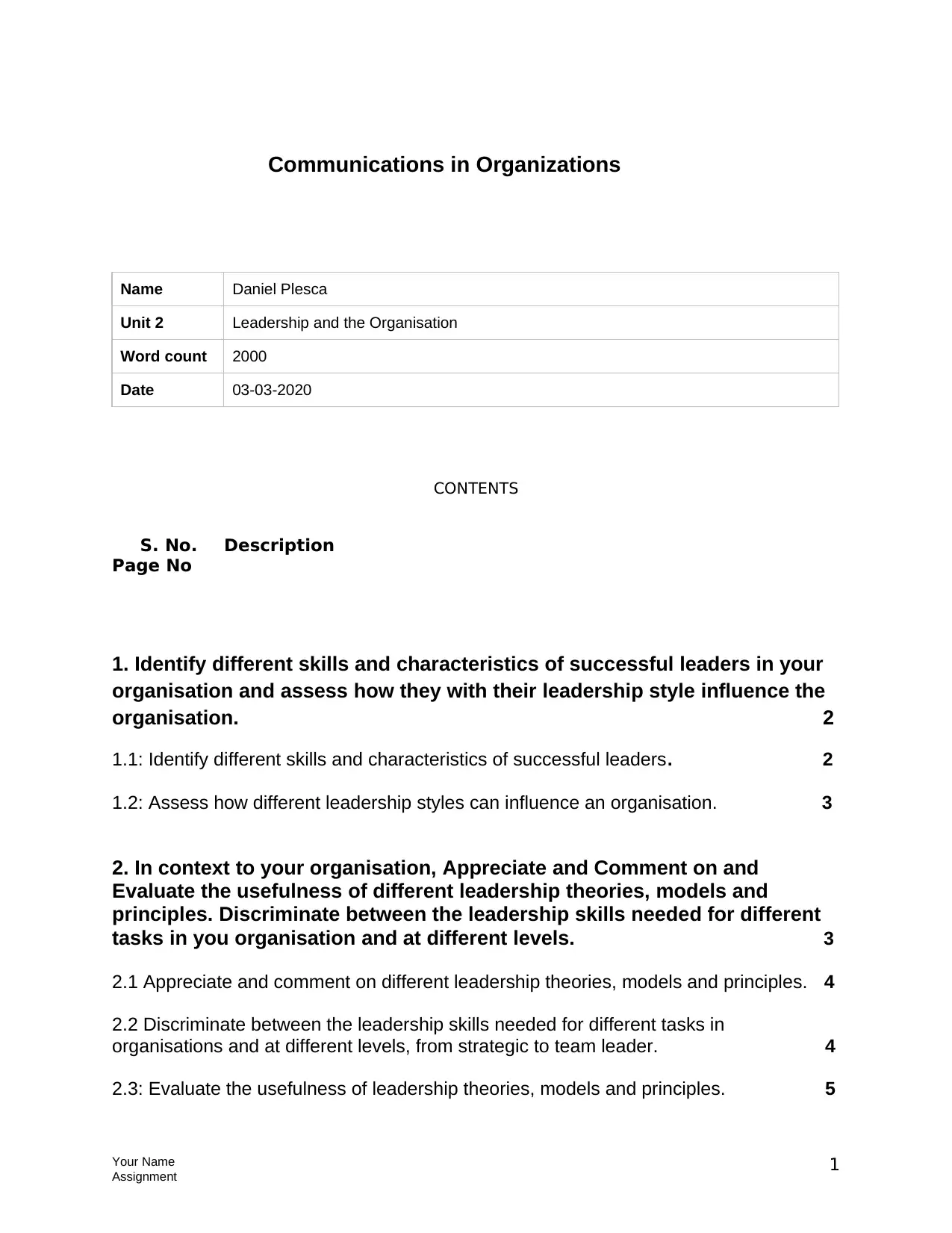
Communications in Organizations
Name Daniel Plesca
Unit 2 Leadership and the Organisation
Word count 2000
Date 03-03-2020
CONTENTS
S. No. Description
Page No
1. Identify different skills and characteristics of successful leaders in your
organisation and assess how they with their leadership style influence the
organisation. 2
1.1: Identify different skills and characteristics of successful leaders. 2
1.2: Assess how different leadership styles can influence an organisation. 3
2. In context to your organisation, Appreciate and Comment on and
Evaluate the usefulness of different leadership theories, models and
principles. Discriminate between the leadership skills needed for different
tasks in you organisation and at different levels. 3
2.1 Appreciate and comment on different leadership theories, models and principles. 4
2.2 Discriminate between the leadership skills needed for different tasks in
organisations and at different levels, from strategic to team leader. 4
2.3: Evaluate the usefulness of leadership theories, models and principles. 5
Your Name
Assignment 1
Name Daniel Plesca
Unit 2 Leadership and the Organisation
Word count 2000
Date 03-03-2020
CONTENTS
S. No. Description
Page No
1. Identify different skills and characteristics of successful leaders in your
organisation and assess how they with their leadership style influence the
organisation. 2
1.1: Identify different skills and characteristics of successful leaders. 2
1.2: Assess how different leadership styles can influence an organisation. 3
2. In context to your organisation, Appreciate and Comment on and
Evaluate the usefulness of different leadership theories, models and
principles. Discriminate between the leadership skills needed for different
tasks in you organisation and at different levels. 3
2.1 Appreciate and comment on different leadership theories, models and principles. 4
2.2 Discriminate between the leadership skills needed for different tasks in
organisations and at different levels, from strategic to team leader. 4
2.3: Evaluate the usefulness of leadership theories, models and principles. 5
Your Name
Assignment 1
Paraphrase This Document
Need a fresh take? Get an instant paraphrase of this document with our AI Paraphraser
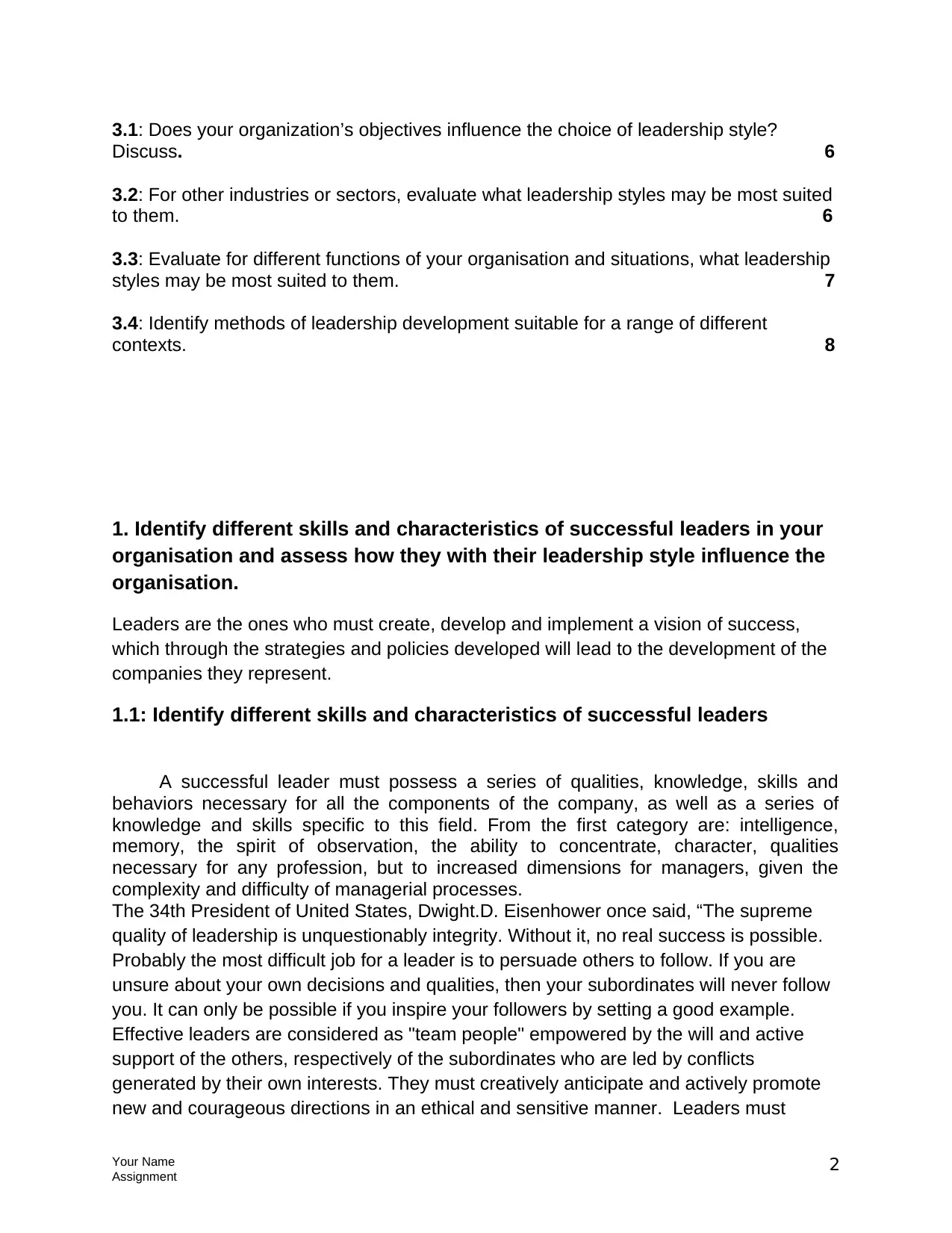
3.1: Does your organization’s objectives influence the choice of leadership style?
Discuss. 6
3.2: For other industries or sectors, evaluate what leadership styles may be most suited
to them. 6
3.3: Evaluate for different functions of your organisation and situations, what leadership
styles may be most suited to them. 7
3.4: Identify methods of leadership development suitable for a range of different
contexts. 8
1. Identify different skills and characteristics of successful leaders in your
organisation and assess how they with their leadership style influence the
organisation.
Leaders are the ones who must create, develop and implement a vision of success,
which through the strategies and policies developed will lead to the development of the
companies they represent.
1.1: Identify different skills and characteristics of successful leaders
A successful leader must possess a series of qualities, knowledge, skills and
behaviors necessary for all the components of the company, as well as a series of
knowledge and skills specific to this field. From the first category are: intelligence,
memory, the spirit of observation, the ability to concentrate, character, qualities
necessary for any profession, but to increased dimensions for managers, given the
complexity and difficulty of managerial processes.
The 34th President of United States, Dwight.D. Eisenhower once said, “The supreme
quality of leadership is unquestionably integrity. Without it, no real success is possible.
Probably the most difficult job for a leader is to persuade others to follow. If you are
unsure about your own decisions and qualities, then your subordinates will never follow
you. It can only be possible if you inspire your followers by setting a good example.
Effective leaders are considered as "team people" empowered by the will and active
support of the others, respectively of the subordinates who are led by conflicts
generated by their own interests. They must creatively anticipate and actively promote
new and courageous directions in an ethical and sensitive manner. Leaders must
Your Name
Assignment 2
Discuss. 6
3.2: For other industries or sectors, evaluate what leadership styles may be most suited
to them. 6
3.3: Evaluate for different functions of your organisation and situations, what leadership
styles may be most suited to them. 7
3.4: Identify methods of leadership development suitable for a range of different
contexts. 8
1. Identify different skills and characteristics of successful leaders in your
organisation and assess how they with their leadership style influence the
organisation.
Leaders are the ones who must create, develop and implement a vision of success,
which through the strategies and policies developed will lead to the development of the
companies they represent.
1.1: Identify different skills and characteristics of successful leaders
A successful leader must possess a series of qualities, knowledge, skills and
behaviors necessary for all the components of the company, as well as a series of
knowledge and skills specific to this field. From the first category are: intelligence,
memory, the spirit of observation, the ability to concentrate, character, qualities
necessary for any profession, but to increased dimensions for managers, given the
complexity and difficulty of managerial processes.
The 34th President of United States, Dwight.D. Eisenhower once said, “The supreme
quality of leadership is unquestionably integrity. Without it, no real success is possible.
Probably the most difficult job for a leader is to persuade others to follow. If you are
unsure about your own decisions and qualities, then your subordinates will never follow
you. It can only be possible if you inspire your followers by setting a good example.
Effective leaders are considered as "team people" empowered by the will and active
support of the others, respectively of the subordinates who are led by conflicts
generated by their own interests. They must creatively anticipate and actively promote
new and courageous directions in an ethical and sensitive manner. Leaders must
Your Name
Assignment 2
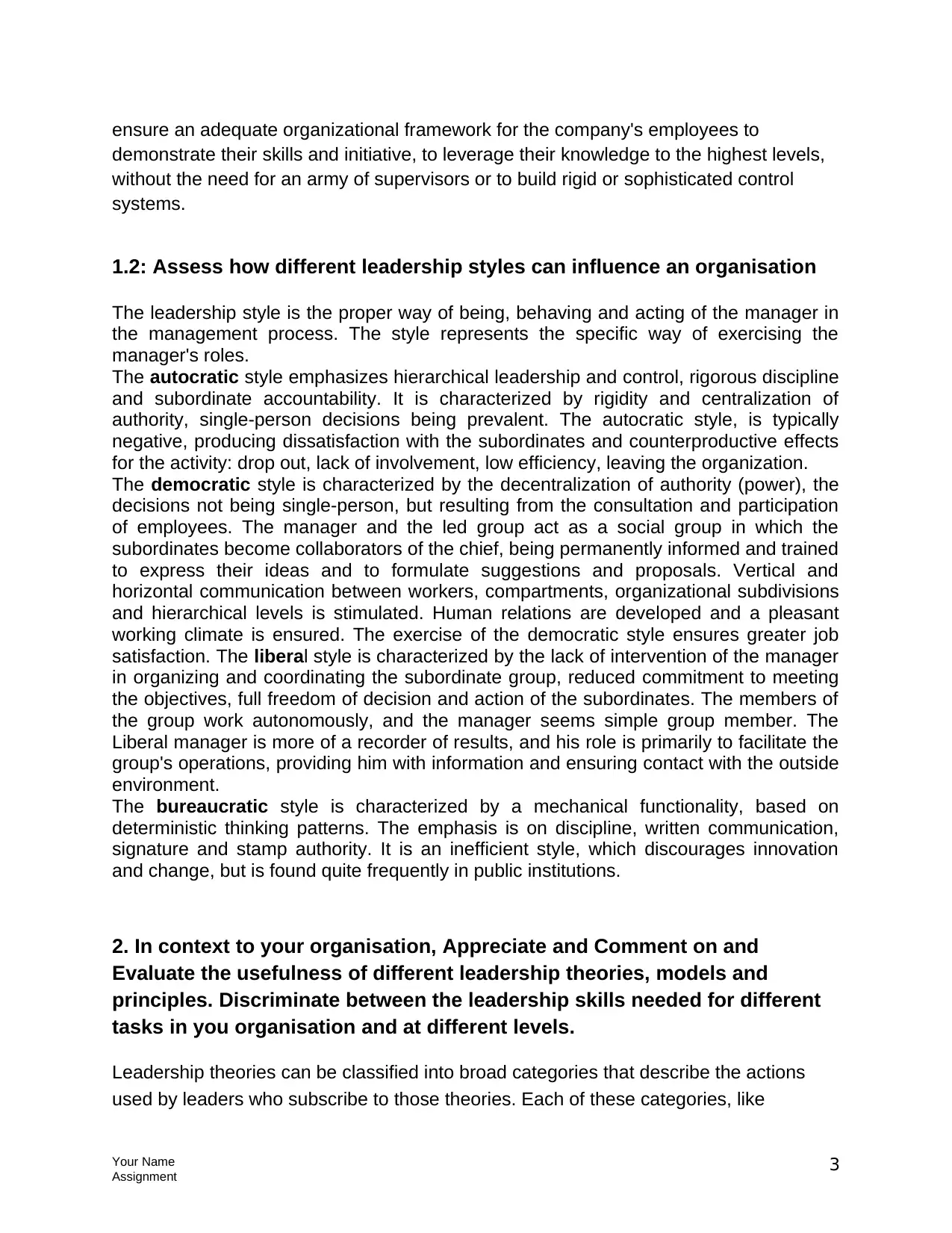
ensure an adequate organizational framework for the company's employees to
demonstrate their skills and initiative, to leverage their knowledge to the highest levels,
without the need for an army of supervisors or to build rigid or sophisticated control
systems.
1.2: Assess how different leadership styles can influence an organisation
The leadership style is the proper way of being, behaving and acting of the manager in
the management process. The style represents the specific way of exercising the
manager's roles.
The autocratic style emphasizes hierarchical leadership and control, rigorous discipline
and subordinate accountability. It is characterized by rigidity and centralization of
authority, single-person decisions being prevalent. The autocratic style, is typically
negative, producing dissatisfaction with the subordinates and counterproductive effects
for the activity: drop out, lack of involvement, low efficiency, leaving the organization.
The democratic style is characterized by the decentralization of authority (power), the
decisions not being single-person, but resulting from the consultation and participation
of employees. The manager and the led group act as a social group in which the
subordinates become collaborators of the chief, being permanently informed and trained
to express their ideas and to formulate suggestions and proposals. Vertical and
horizontal communication between workers, compartments, organizational subdivisions
and hierarchical levels is stimulated. Human relations are developed and a pleasant
working climate is ensured. The exercise of the democratic style ensures greater job
satisfaction. The liberal style is characterized by the lack of intervention of the manager
in organizing and coordinating the subordinate group, reduced commitment to meeting
the objectives, full freedom of decision and action of the subordinates. The members of
the group work autonomously, and the manager seems simple group member. The
Liberal manager is more of a recorder of results, and his role is primarily to facilitate the
group's operations, providing him with information and ensuring contact with the outside
environment.
The bureaucratic style is characterized by a mechanical functionality, based on
deterministic thinking patterns. The emphasis is on discipline, written communication,
signature and stamp authority. It is an inefficient style, which discourages innovation
and change, but is found quite frequently in public institutions.
2. In context to your organisation, Appreciate and Comment on and
Evaluate the usefulness of different leadership theories, models and
principles. Discriminate between the leadership skills needed for different
tasks in you organisation and at different levels.
Leadership theories can be classified into broad categories that describe the actions
used by leaders who subscribe to those theories. Each of these categories, like
Your Name
Assignment 3
demonstrate their skills and initiative, to leverage their knowledge to the highest levels,
without the need for an army of supervisors or to build rigid or sophisticated control
systems.
1.2: Assess how different leadership styles can influence an organisation
The leadership style is the proper way of being, behaving and acting of the manager in
the management process. The style represents the specific way of exercising the
manager's roles.
The autocratic style emphasizes hierarchical leadership and control, rigorous discipline
and subordinate accountability. It is characterized by rigidity and centralization of
authority, single-person decisions being prevalent. The autocratic style, is typically
negative, producing dissatisfaction with the subordinates and counterproductive effects
for the activity: drop out, lack of involvement, low efficiency, leaving the organization.
The democratic style is characterized by the decentralization of authority (power), the
decisions not being single-person, but resulting from the consultation and participation
of employees. The manager and the led group act as a social group in which the
subordinates become collaborators of the chief, being permanently informed and trained
to express their ideas and to formulate suggestions and proposals. Vertical and
horizontal communication between workers, compartments, organizational subdivisions
and hierarchical levels is stimulated. Human relations are developed and a pleasant
working climate is ensured. The exercise of the democratic style ensures greater job
satisfaction. The liberal style is characterized by the lack of intervention of the manager
in organizing and coordinating the subordinate group, reduced commitment to meeting
the objectives, full freedom of decision and action of the subordinates. The members of
the group work autonomously, and the manager seems simple group member. The
Liberal manager is more of a recorder of results, and his role is primarily to facilitate the
group's operations, providing him with information and ensuring contact with the outside
environment.
The bureaucratic style is characterized by a mechanical functionality, based on
deterministic thinking patterns. The emphasis is on discipline, written communication,
signature and stamp authority. It is an inefficient style, which discourages innovation
and change, but is found quite frequently in public institutions.
2. In context to your organisation, Appreciate and Comment on and
Evaluate the usefulness of different leadership theories, models and
principles. Discriminate between the leadership skills needed for different
tasks in you organisation and at different levels.
Leadership theories can be classified into broad categories that describe the actions
used by leaders who subscribe to those theories. Each of these categories, like
Your Name
Assignment 3
⊘ This is a preview!⊘
Do you want full access?
Subscribe today to unlock all pages.

Trusted by 1+ million students worldwide
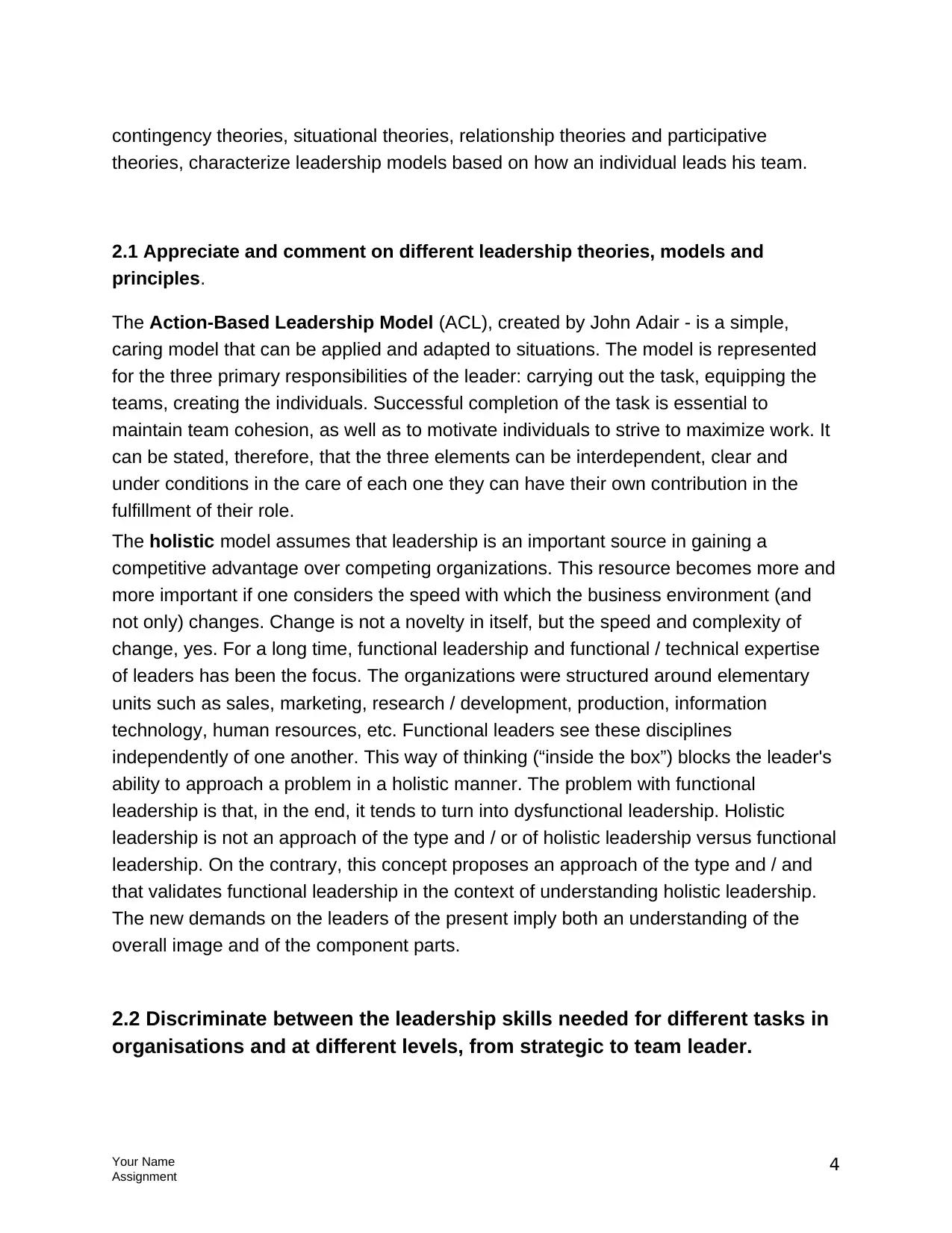
contingency theories, situational theories, relationship theories and participative
theories, characterize leadership models based on how an individual leads his team.
2.1 Appreciate and comment on different leadership theories, models and
principles.
The Action-Based Leadership Model (ACL), created by John Adair - is a simple,
caring model that can be applied and adapted to situations. The model is represented
for the three primary responsibilities of the leader: carrying out the task, equipping the
teams, creating the individuals. Successful completion of the task is essential to
maintain team cohesion, as well as to motivate individuals to strive to maximize work. It
can be stated, therefore, that the three elements can be interdependent, clear and
under conditions in the care of each one they can have their own contribution in the
fulfillment of their role.
The holistic model assumes that leadership is an important source in gaining a
competitive advantage over competing organizations. This resource becomes more and
more important if one considers the speed with which the business environment (and
not only) changes. Change is not a novelty in itself, but the speed and complexity of
change, yes. For a long time, functional leadership and functional / technical expertise
of leaders has been the focus. The organizations were structured around elementary
units such as sales, marketing, research / development, production, information
technology, human resources, etc. Functional leaders see these disciplines
independently of one another. This way of thinking (“inside the box”) blocks the leader's
ability to approach a problem in a holistic manner. The problem with functional
leadership is that, in the end, it tends to turn into dysfunctional leadership. Holistic
leadership is not an approach of the type and / or of holistic leadership versus functional
leadership. On the contrary, this concept proposes an approach of the type and / and
that validates functional leadership in the context of understanding holistic leadership.
The new demands on the leaders of the present imply both an understanding of the
overall image and of the component parts.
2.2 Discriminate between the leadership skills needed for different tasks in
organisations and at different levels, from strategic to team leader.
Your Name
Assignment 4
theories, characterize leadership models based on how an individual leads his team.
2.1 Appreciate and comment on different leadership theories, models and
principles.
The Action-Based Leadership Model (ACL), created by John Adair - is a simple,
caring model that can be applied and adapted to situations. The model is represented
for the three primary responsibilities of the leader: carrying out the task, equipping the
teams, creating the individuals. Successful completion of the task is essential to
maintain team cohesion, as well as to motivate individuals to strive to maximize work. It
can be stated, therefore, that the three elements can be interdependent, clear and
under conditions in the care of each one they can have their own contribution in the
fulfillment of their role.
The holistic model assumes that leadership is an important source in gaining a
competitive advantage over competing organizations. This resource becomes more and
more important if one considers the speed with which the business environment (and
not only) changes. Change is not a novelty in itself, but the speed and complexity of
change, yes. For a long time, functional leadership and functional / technical expertise
of leaders has been the focus. The organizations were structured around elementary
units such as sales, marketing, research / development, production, information
technology, human resources, etc. Functional leaders see these disciplines
independently of one another. This way of thinking (“inside the box”) blocks the leader's
ability to approach a problem in a holistic manner. The problem with functional
leadership is that, in the end, it tends to turn into dysfunctional leadership. Holistic
leadership is not an approach of the type and / or of holistic leadership versus functional
leadership. On the contrary, this concept proposes an approach of the type and / and
that validates functional leadership in the context of understanding holistic leadership.
The new demands on the leaders of the present imply both an understanding of the
overall image and of the component parts.
2.2 Discriminate between the leadership skills needed for different tasks in
organisations and at different levels, from strategic to team leader.
Your Name
Assignment 4
Paraphrase This Document
Need a fresh take? Get an instant paraphrase of this document with our AI Paraphraser
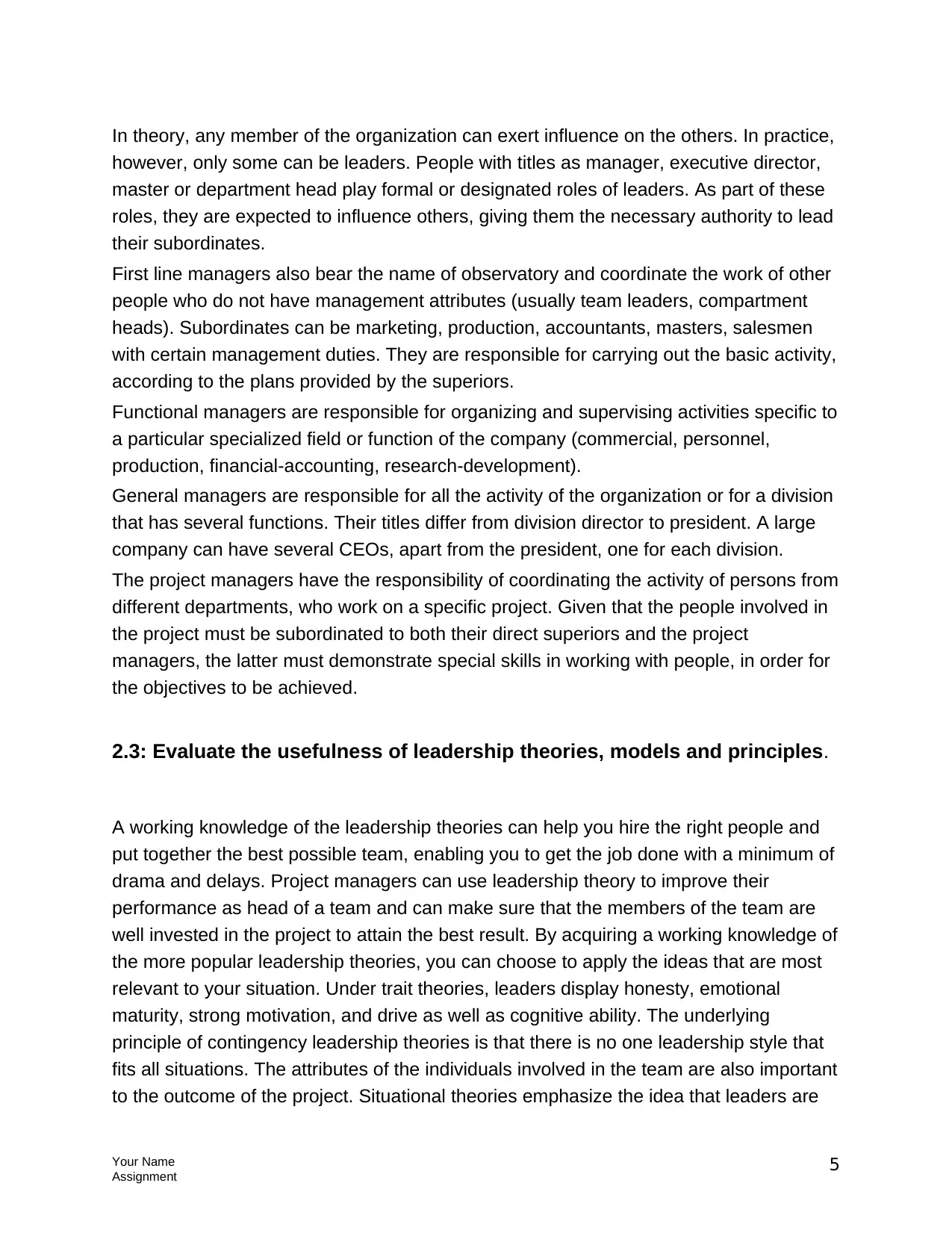
In theory, any member of the organization can exert influence on the others. In practice,
however, only some can be leaders. People with titles as manager, executive director,
master or department head play formal or designated roles of leaders. As part of these
roles, they are expected to influence others, giving them the necessary authority to lead
their subordinates.
First line managers also bear the name of observatory and coordinate the work of other
people who do not have management attributes (usually team leaders, compartment
heads). Subordinates can be marketing, production, accountants, masters, salesmen
with certain management duties. They are responsible for carrying out the basic activity,
according to the plans provided by the superiors.
Functional managers are responsible for organizing and supervising activities specific to
a particular specialized field or function of the company (commercial, personnel,
production, financial-accounting, research-development).
General managers are responsible for all the activity of the organization or for a division
that has several functions. Their titles differ from division director to president. A large
company can have several CEOs, apart from the president, one for each division.
The project managers have the responsibility of coordinating the activity of persons from
different departments, who work on a specific project. Given that the people involved in
the project must be subordinated to both their direct superiors and the project
managers, the latter must demonstrate special skills in working with people, in order for
the objectives to be achieved.
2.3: Evaluate the usefulness of leadership theories, models and principles.
A working knowledge of the leadership theories can help you hire the right people and
put together the best possible team, enabling you to get the job done with a minimum of
drama and delays. Project managers can use leadership theory to improve their
performance as head of a team and can make sure that the members of the team are
well invested in the project to attain the best result. By acquiring a working knowledge of
the more popular leadership theories, you can choose to apply the ideas that are most
relevant to your situation. Under trait theories, leaders display honesty, emotional
maturity, strong motivation, and drive as well as cognitive ability. The underlying
principle of contingency leadership theories is that there is no one leadership style that
fits all situations. The attributes of the individuals involved in the team are also important
to the outcome of the project. Situational theories emphasize the idea that leaders are
Your Name
Assignment 5
however, only some can be leaders. People with titles as manager, executive director,
master or department head play formal or designated roles of leaders. As part of these
roles, they are expected to influence others, giving them the necessary authority to lead
their subordinates.
First line managers also bear the name of observatory and coordinate the work of other
people who do not have management attributes (usually team leaders, compartment
heads). Subordinates can be marketing, production, accountants, masters, salesmen
with certain management duties. They are responsible for carrying out the basic activity,
according to the plans provided by the superiors.
Functional managers are responsible for organizing and supervising activities specific to
a particular specialized field or function of the company (commercial, personnel,
production, financial-accounting, research-development).
General managers are responsible for all the activity of the organization or for a division
that has several functions. Their titles differ from division director to president. A large
company can have several CEOs, apart from the president, one for each division.
The project managers have the responsibility of coordinating the activity of persons from
different departments, who work on a specific project. Given that the people involved in
the project must be subordinated to both their direct superiors and the project
managers, the latter must demonstrate special skills in working with people, in order for
the objectives to be achieved.
2.3: Evaluate the usefulness of leadership theories, models and principles.
A working knowledge of the leadership theories can help you hire the right people and
put together the best possible team, enabling you to get the job done with a minimum of
drama and delays. Project managers can use leadership theory to improve their
performance as head of a team and can make sure that the members of the team are
well invested in the project to attain the best result. By acquiring a working knowledge of
the more popular leadership theories, you can choose to apply the ideas that are most
relevant to your situation. Under trait theories, leaders display honesty, emotional
maturity, strong motivation, and drive as well as cognitive ability. The underlying
principle of contingency leadership theories is that there is no one leadership style that
fits all situations. The attributes of the individuals involved in the team are also important
to the outcome of the project. Situational theories emphasize the idea that leaders are
Your Name
Assignment 5

prompted to behave. in a way that is determined by the circumstances of the task at
hand. This is true whether they are acting alone or if they are supported by others who
also see the path to success. In transformational leadership theory, a strong leader
inspires followers by emphasizing the significance of the task at hand. By enabling team
members to feel they are performing an important task, the team leader can motivate
the team to perform well. Underlying principles of current leadership theories state that
good leaders reconcile the goals of the project with the interests of team members.
Making sense of divergent theories means understanding the relationship between the
leader and the team, the range of management styles, and the degree to which team
members are allowed to have their voices heard.
3.1: Does your organization’s objectives influence the choice of leadership
style? Discuss.
The main activity on which a leader has to fulfill is to manage the objective of the
respective company, to share with others the vision of the company as a whole, to
explain all the proposed standards for fulfillment and to administer the communication
means necessary for the connection between the different parties.
The specific activity of an organization demands a specific leadership style. The
missions, the structure of the organization, the individuals that make up the
organization, form the coordinates of the leadership style. Therefore, this style, in order
to be optimal, must mean the ability of the management cadres to adapt to the
situations, to notice the essential elements, treating the problems with which they differ.
is confronted, using for each situation, the most suitable methods. However, regardless
of the meanings that the concept of leadership style has in the specialized literature, it is
certain that they all share a common point, namely the close connection between the
way of exercising the functions of management, the conceptions, the psychic capacities
and particularities of the leader and the specific concrete conditions. activities.
Regarding the components of the leadership style, it can be said that this results from
the combination of two fundamental attitudes, which the manager expresses differently:
first, the personal commitment to the objectives of the unit, and then the cooperation
that is established with the other members of the unit.
3.2: For other industries or sectors, evaluate what leadership styles may be
most suited to them.
The leadership styles will be different in a unit with a low level of technical endowment
and in a strongly equipped unit, in a large unit and in a small unit; in a territorially
concentrated unit and in a territorially dispersed unit.
Your Name
Assignment 6
hand. This is true whether they are acting alone or if they are supported by others who
also see the path to success. In transformational leadership theory, a strong leader
inspires followers by emphasizing the significance of the task at hand. By enabling team
members to feel they are performing an important task, the team leader can motivate
the team to perform well. Underlying principles of current leadership theories state that
good leaders reconcile the goals of the project with the interests of team members.
Making sense of divergent theories means understanding the relationship between the
leader and the team, the range of management styles, and the degree to which team
members are allowed to have their voices heard.
3.1: Does your organization’s objectives influence the choice of leadership
style? Discuss.
The main activity on which a leader has to fulfill is to manage the objective of the
respective company, to share with others the vision of the company as a whole, to
explain all the proposed standards for fulfillment and to administer the communication
means necessary for the connection between the different parties.
The specific activity of an organization demands a specific leadership style. The
missions, the structure of the organization, the individuals that make up the
organization, form the coordinates of the leadership style. Therefore, this style, in order
to be optimal, must mean the ability of the management cadres to adapt to the
situations, to notice the essential elements, treating the problems with which they differ.
is confronted, using for each situation, the most suitable methods. However, regardless
of the meanings that the concept of leadership style has in the specialized literature, it is
certain that they all share a common point, namely the close connection between the
way of exercising the functions of management, the conceptions, the psychic capacities
and particularities of the leader and the specific concrete conditions. activities.
Regarding the components of the leadership style, it can be said that this results from
the combination of two fundamental attitudes, which the manager expresses differently:
first, the personal commitment to the objectives of the unit, and then the cooperation
that is established with the other members of the unit.
3.2: For other industries or sectors, evaluate what leadership styles may be
most suited to them.
The leadership styles will be different in a unit with a low level of technical endowment
and in a strongly equipped unit, in a large unit and in a small unit; in a territorially
concentrated unit and in a territorially dispersed unit.
Your Name
Assignment 6
⊘ This is a preview!⊘
Do you want full access?
Subscribe today to unlock all pages.

Trusted by 1+ million students worldwide
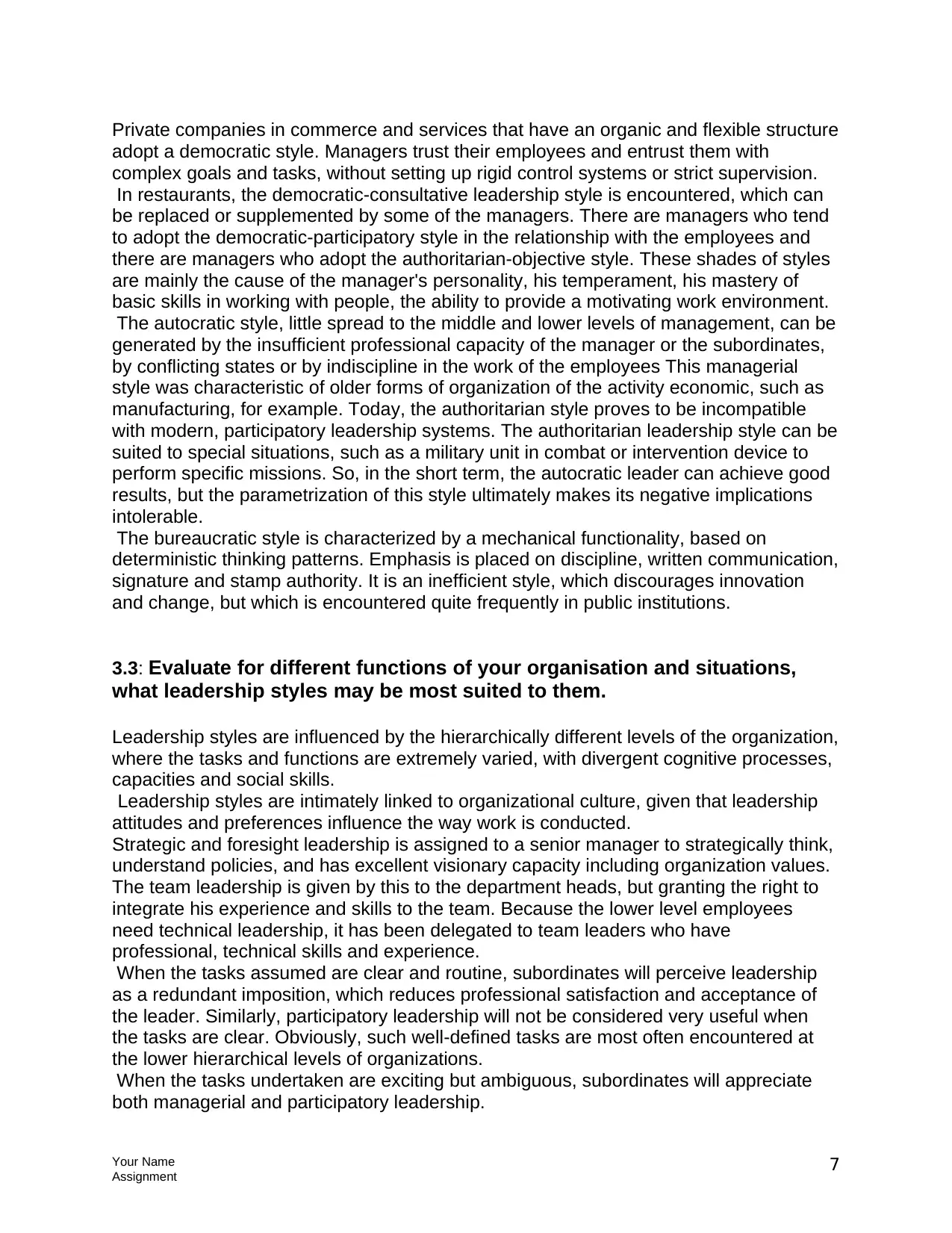
Private companies in commerce and services that have an organic and flexible structure
adopt a democratic style. Managers trust their employees and entrust them with
complex goals and tasks, without setting up rigid control systems or strict supervision.
In restaurants, the democratic-consultative leadership style is encountered, which can
be replaced or supplemented by some of the managers. There are managers who tend
to adopt the democratic-participatory style in the relationship with the employees and
there are managers who adopt the authoritarian-objective style. These shades of styles
are mainly the cause of the manager's personality, his temperament, his mastery of
basic skills in working with people, the ability to provide a motivating work environment.
The autocratic style, little spread to the middle and lower levels of management, can be
generated by the insufficient professional capacity of the manager or the subordinates,
by conflicting states or by indiscipline in the work of the employees This managerial
style was characteristic of older forms of organization of the activity economic, such as
manufacturing, for example. Today, the authoritarian style proves to be incompatible
with modern, participatory leadership systems. The authoritarian leadership style can be
suited to special situations, such as a military unit in combat or intervention device to
perform specific missions. So, in the short term, the autocratic leader can achieve good
results, but the parametrization of this style ultimately makes its negative implications
intolerable.
The bureaucratic style is characterized by a mechanical functionality, based on
deterministic thinking patterns. Emphasis is placed on discipline, written communication,
signature and stamp authority. It is an inefficient style, which discourages innovation
and change, but which is encountered quite frequently in public institutions.
3.3: Evaluate for different functions of your organisation and situations,
what leadership styles may be most suited to them.
Leadership styles are influenced by the hierarchically different levels of the organization,
where the tasks and functions are extremely varied, with divergent cognitive processes,
capacities and social skills.
Leadership styles are intimately linked to organizational culture, given that leadership
attitudes and preferences influence the way work is conducted.
Strategic and foresight leadership is assigned to a senior manager to strategically think,
understand policies, and has excellent visionary capacity including organization values.
The team leadership is given by this to the department heads, but granting the right to
integrate his experience and skills to the team. Because the lower level employees
need technical leadership, it has been delegated to team leaders who have
professional, technical skills and experience.
When the tasks assumed are clear and routine, subordinates will perceive leadership
as a redundant imposition, which reduces professional satisfaction and acceptance of
the leader. Similarly, participatory leadership will not be considered very useful when
the tasks are clear. Obviously, such well-defined tasks are most often encountered at
the lower hierarchical levels of organizations.
When the tasks undertaken are exciting but ambiguous, subordinates will appreciate
both managerial and participatory leadership.
Your Name
Assignment 7
adopt a democratic style. Managers trust their employees and entrust them with
complex goals and tasks, without setting up rigid control systems or strict supervision.
In restaurants, the democratic-consultative leadership style is encountered, which can
be replaced or supplemented by some of the managers. There are managers who tend
to adopt the democratic-participatory style in the relationship with the employees and
there are managers who adopt the authoritarian-objective style. These shades of styles
are mainly the cause of the manager's personality, his temperament, his mastery of
basic skills in working with people, the ability to provide a motivating work environment.
The autocratic style, little spread to the middle and lower levels of management, can be
generated by the insufficient professional capacity of the manager or the subordinates,
by conflicting states or by indiscipline in the work of the employees This managerial
style was characteristic of older forms of organization of the activity economic, such as
manufacturing, for example. Today, the authoritarian style proves to be incompatible
with modern, participatory leadership systems. The authoritarian leadership style can be
suited to special situations, such as a military unit in combat or intervention device to
perform specific missions. So, in the short term, the autocratic leader can achieve good
results, but the parametrization of this style ultimately makes its negative implications
intolerable.
The bureaucratic style is characterized by a mechanical functionality, based on
deterministic thinking patterns. Emphasis is placed on discipline, written communication,
signature and stamp authority. It is an inefficient style, which discourages innovation
and change, but which is encountered quite frequently in public institutions.
3.3: Evaluate for different functions of your organisation and situations,
what leadership styles may be most suited to them.
Leadership styles are influenced by the hierarchically different levels of the organization,
where the tasks and functions are extremely varied, with divergent cognitive processes,
capacities and social skills.
Leadership styles are intimately linked to organizational culture, given that leadership
attitudes and preferences influence the way work is conducted.
Strategic and foresight leadership is assigned to a senior manager to strategically think,
understand policies, and has excellent visionary capacity including organization values.
The team leadership is given by this to the department heads, but granting the right to
integrate his experience and skills to the team. Because the lower level employees
need technical leadership, it has been delegated to team leaders who have
professional, technical skills and experience.
When the tasks assumed are clear and routine, subordinates will perceive leadership
as a redundant imposition, which reduces professional satisfaction and acceptance of
the leader. Similarly, participatory leadership will not be considered very useful when
the tasks are clear. Obviously, such well-defined tasks are most often encountered at
the lower hierarchical levels of organizations.
When the tasks undertaken are exciting but ambiguous, subordinates will appreciate
both managerial and participatory leadership.
Your Name
Assignment 7
Paraphrase This Document
Need a fresh take? Get an instant paraphrase of this document with our AI Paraphraser
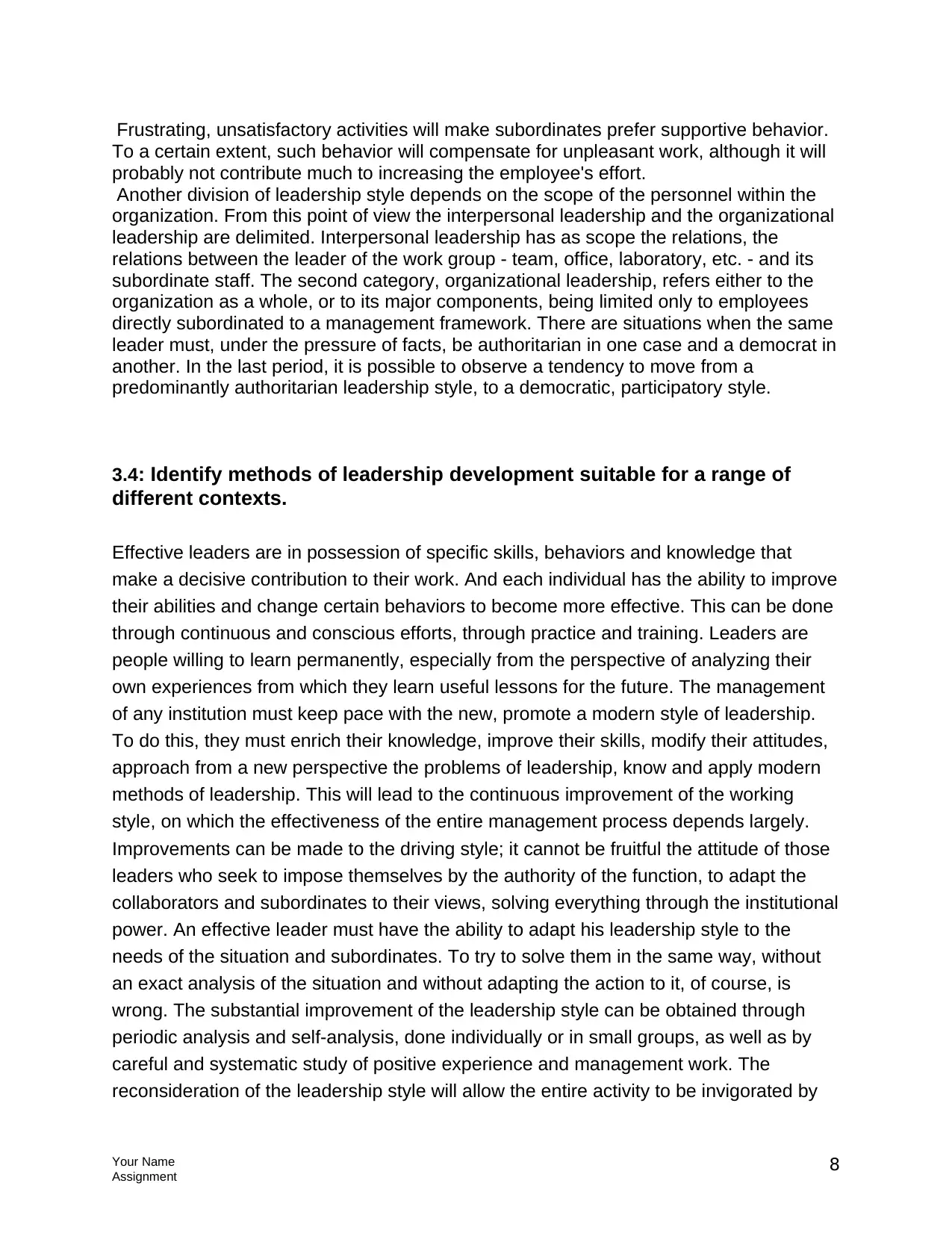
Frustrating, unsatisfactory activities will make subordinates prefer supportive behavior.
To a certain extent, such behavior will compensate for unpleasant work, although it will
probably not contribute much to increasing the employee's effort.
Another division of leadership style depends on the scope of the personnel within the
organization. From this point of view the interpersonal leadership and the organizational
leadership are delimited. Interpersonal leadership has as scope the relations, the
relations between the leader of the work group - team, office, laboratory, etc. - and its
subordinate staff. The second category, organizational leadership, refers either to the
organization as a whole, or to its major components, being limited only to employees
directly subordinated to a management framework. There are situations when the same
leader must, under the pressure of facts, be authoritarian in one case and a democrat in
another. In the last period, it is possible to observe a tendency to move from a
predominantly authoritarian leadership style, to a democratic, participatory style.
3.4: Identify methods of leadership development suitable for a range of
different contexts.
Effective leaders are in possession of specific skills, behaviors and knowledge that
make a decisive contribution to their work. And each individual has the ability to improve
their abilities and change certain behaviors to become more effective. This can be done
through continuous and conscious efforts, through practice and training. Leaders are
people willing to learn permanently, especially from the perspective of analyzing their
own experiences from which they learn useful lessons for the future. The management
of any institution must keep pace with the new, promote a modern style of leadership.
To do this, they must enrich their knowledge, improve their skills, modify their attitudes,
approach from a new perspective the problems of leadership, know and apply modern
methods of leadership. This will lead to the continuous improvement of the working
style, on which the effectiveness of the entire management process depends largely.
Improvements can be made to the driving style; it cannot be fruitful the attitude of those
leaders who seek to impose themselves by the authority of the function, to adapt the
collaborators and subordinates to their views, solving everything through the institutional
power. An effective leader must have the ability to adapt his leadership style to the
needs of the situation and subordinates. To try to solve them in the same way, without
an exact analysis of the situation and without adapting the action to it, of course, is
wrong. The substantial improvement of the leadership style can be obtained through
periodic analysis and self-analysis, done individually or in small groups, as well as by
careful and systematic study of positive experience and management work. The
reconsideration of the leadership style will allow the entire activity to be invigorated by
Your Name
Assignment 8
To a certain extent, such behavior will compensate for unpleasant work, although it will
probably not contribute much to increasing the employee's effort.
Another division of leadership style depends on the scope of the personnel within the
organization. From this point of view the interpersonal leadership and the organizational
leadership are delimited. Interpersonal leadership has as scope the relations, the
relations between the leader of the work group - team, office, laboratory, etc. - and its
subordinate staff. The second category, organizational leadership, refers either to the
organization as a whole, or to its major components, being limited only to employees
directly subordinated to a management framework. There are situations when the same
leader must, under the pressure of facts, be authoritarian in one case and a democrat in
another. In the last period, it is possible to observe a tendency to move from a
predominantly authoritarian leadership style, to a democratic, participatory style.
3.4: Identify methods of leadership development suitable for a range of
different contexts.
Effective leaders are in possession of specific skills, behaviors and knowledge that
make a decisive contribution to their work. And each individual has the ability to improve
their abilities and change certain behaviors to become more effective. This can be done
through continuous and conscious efforts, through practice and training. Leaders are
people willing to learn permanently, especially from the perspective of analyzing their
own experiences from which they learn useful lessons for the future. The management
of any institution must keep pace with the new, promote a modern style of leadership.
To do this, they must enrich their knowledge, improve their skills, modify their attitudes,
approach from a new perspective the problems of leadership, know and apply modern
methods of leadership. This will lead to the continuous improvement of the working
style, on which the effectiveness of the entire management process depends largely.
Improvements can be made to the driving style; it cannot be fruitful the attitude of those
leaders who seek to impose themselves by the authority of the function, to adapt the
collaborators and subordinates to their views, solving everything through the institutional
power. An effective leader must have the ability to adapt his leadership style to the
needs of the situation and subordinates. To try to solve them in the same way, without
an exact analysis of the situation and without adapting the action to it, of course, is
wrong. The substantial improvement of the leadership style can be obtained through
periodic analysis and self-analysis, done individually or in small groups, as well as by
careful and systematic study of positive experience and management work. The
reconsideration of the leadership style will allow the entire activity to be invigorated by
Your Name
Assignment 8
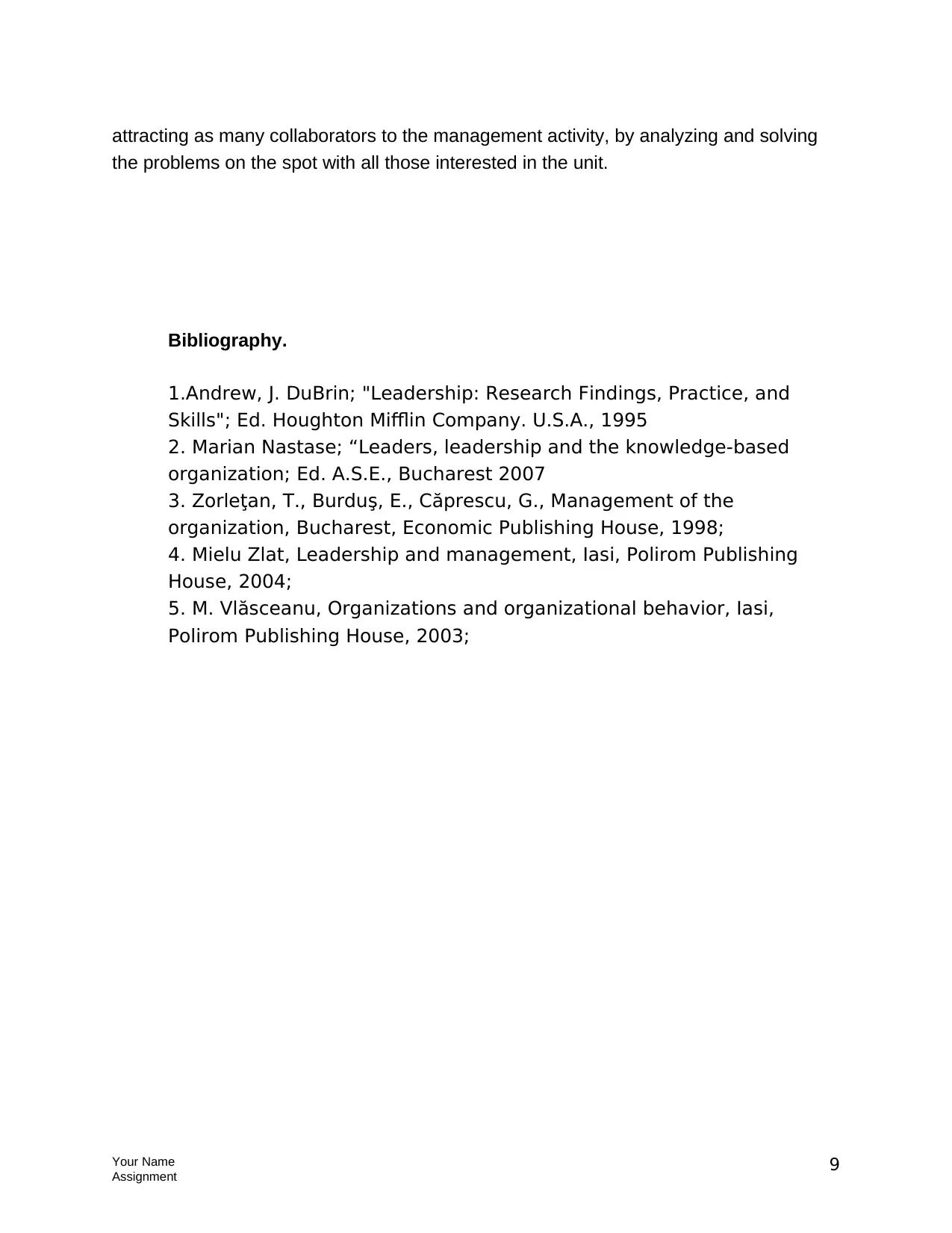
attracting as many collaborators to the management activity, by analyzing and solving
the problems on the spot with all those interested in the unit.
Bibliography.
1.Andrew, J. DuBrin; "Leadership: Research Findings, Practice, and
Skills"; Ed. Houghton Mifflin Company. U.S.A., 1995
2. Marian Nastase; “Leaders, leadership and the knowledge-based
organization; Ed. A.S.E., Bucharest 2007
3. Zorleţan, T., Burduş, E., Căprescu, G., Management of the
organization, Bucharest, Economic Publishing House, 1998;
4. Mielu Zlat, Leadership and management, Iasi, Polirom Publishing
House, 2004;
5. M. Vlăsceanu, Organizations and organizational behavior, Iasi,
Polirom Publishing House, 2003;
Your Name
Assignment 9
the problems on the spot with all those interested in the unit.
Bibliography.
1.Andrew, J. DuBrin; "Leadership: Research Findings, Practice, and
Skills"; Ed. Houghton Mifflin Company. U.S.A., 1995
2. Marian Nastase; “Leaders, leadership and the knowledge-based
organization; Ed. A.S.E., Bucharest 2007
3. Zorleţan, T., Burduş, E., Căprescu, G., Management of the
organization, Bucharest, Economic Publishing House, 1998;
4. Mielu Zlat, Leadership and management, Iasi, Polirom Publishing
House, 2004;
5. M. Vlăsceanu, Organizations and organizational behavior, Iasi,
Polirom Publishing House, 2003;
Your Name
Assignment 9
⊘ This is a preview!⊘
Do you want full access?
Subscribe today to unlock all pages.

Trusted by 1+ million students worldwide
1 out of 9
Related Documents
Your All-in-One AI-Powered Toolkit for Academic Success.
+13062052269
info@desklib.com
Available 24*7 on WhatsApp / Email
![[object Object]](/_next/static/media/star-bottom.7253800d.svg)
Unlock your academic potential
Copyright © 2020–2025 A2Z Services. All Rights Reserved. Developed and managed by ZUCOL.





